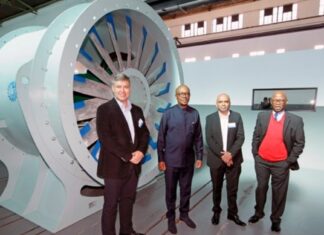Due to the cost and complexity inherited in healthcare projects, BIM tools and processes are an effective platform to aid design, construction and operation. Above saving time and money, if we consider the scope and size of a healthcare project, it is necessary to develop a detailed BIM model in order to adopt the tool and maintain the process fluency of information across all stages of the project.
The process for considering BIM on healthcare project in South Africa is still a relatively new concept, but is being implemented by companies like Arup on current projects – the BIM Institute takes a look.
The Comprehensive Community Based Rehabilitation in Tanzania (CCBRT) Maternity Hospital project – Dar es Salaam
CCBRT is a social enterprise that runs healthcare services in Tanzania, as part of a government partnership and with support from international donors. The new maternity hospital in Dar es Salaam – built to international healthcare standards recently opened. The project comprises ±16,500m2 of theatres, treatment and procedure rooms, a laboratory, a central sterile services department, and standard and private wards. Its six two- and three-storey blocks are interconnected at various levels by external walkways.
The plan
The Arup team provided advice, design and coordination for the mechanical, electrical, wet services and medical gas infrastructure for the hospital site, taking into account its proposed “masterplan” for future development. This plan includes assessing the expected electricity and water loads across the site and advising on what infrastructure should be purchased as part of the maternity hospital development in order to enable cost effective expansion at a later date.
Arup also provided some specialist input when issues arose, to assist the client and the architectural team. This included a geotechnical comment on a site investigation report, some acoustic advice and an Information Communications Technology (ICT) specialist, who led three days of meetings with client representatives to develop an ICT brief for the new hospital to enable CCBRT’s future development plans on the site and beyond.
Arup worked with the team to provide advice and supervision during the construction. As part of this, they used advanced modelling in Revit and live excel links to provide data for costing, energy usage, operation and maintenance.
From Arup’s African building design experience, they indicated to the client the need for there to be knowledgeable staff onsite, monitoring the installation quality on behalf of the client and being able to communicate and resolve any issues with any of the specialist consultants using the live models and associated data sheets. They further indicated to the client the value of being able to utilise digital data created during the design processes, to reach a higher level of expertise in the CCBRT’s maintenance team so that they would be able to cost effectively maintain the systems throughout the building’s life.
BIM implementation
The existing architects and structure had already started with 2D CAD drawings and construction was already quite well underway with the contractor when Arup was brought into the project. A BIM execution plan was therefore set internally by the Arup team and project manager, to define the structure of the team, standards, level of detail etc. This was implemented in phases from Arup’s involvement forward, reflecting specific aspects of the project, and using appropriate methods in each discipline.
BIM model reviews were held at the end of each phase, and experiences were discussed within the implementation team.
Project Delivery Co-ordination
The digital models played an important role in co-ordination. The Revit work set was configured to allow multiple users to work in one building model simultaneously. Models from multiple disciplines were linked into a common model, allowing clashes to be detected and resolved.
Two-dimensional drawings and open source models were efficiently exported using Revit and issued for construction to the contractors to co-ordinate with their workflow.
Design development
Live data sheets were used to develop and define the Mechanical Engineering and Plumbing (MEP) requirements for each room. It allowed the user to see a simple plan of the floor with room numbers, and then identify and approve the ventilation, cooling, electrical, data, lighting, etc. that needed to be provided in that room. The user and the designer could then easily compare the provision with other rooms nearby to ensure consistency.
This information was produced in the building information modelling Revit MEP model, and the output was displayed and analysed in other ways to suit the client’s preferences, including by outputting to an excel file, or to Room Data Sheets (RDS) with one sheet per room.
Results of analysis
Analysis was easier to visualise with this specialised software. Clash detection helped resolve many issues on the design side and insured optimisation was facilitated.
Design challenges
Arup was appointed at a late stage of the project process (with the structure already designed and partially constructed). Typically, they would work closely with the architect and structural engineer at the start of the project to optimise spatial planning for all of the building service systems. This was not possible as the structure was already under construction. Arup therefore worked with the team and the contractor to develop the most economical way forward – which included increasing the area of concrete roof available to allow for the ventilation plant. The chiller location also went through a number of iterations to address concerns about economics, noise and impact on existing structures.
Some benefits to adopting BIM on the project at such a late stage
- Meet the client’s standards for sustainability, air quality, water, wastewater management, and energy performance optimisation. The design had to be developed in close communication with other disciplines and the existing structure, time and cost constraints. This provided a basis for partial BIM implementation within the structure, building services and specialist installation requirements, as well as to allow for accurate costing and analysis of the buildings post occupancy performance.
- Immediate checks on potential technical issues; rapid visualisation and communication were major advantages within the team as well as with other disciplines. The model also allowed for more efficient drawing production.
- Help architects understand the detail drawings, especially the sloping metal roof – a difficult element for the architectural team to draw accurately in a traditional, AutoCAD environment.
- Optimise the detail drawings, making it possible for architects to visualise and develop 3D construction details.
- The preliminary design drawings were delivered directly from the BIM models. Data, including building areas, fire compartment volumes and drawing lists were exported to tabular formats.
- A BIM process works best when the entire team and client plan agree on deliverables and requirements at the inception of a project – as is the norm with many Arup projects. CCBRT proved that BIM can be an asset at any stage assisting and aiding in saving on construction time, accurate documentation generation, coordination resolution, analysis relating to systems optimisation and the related cost savings.
- A tool for planning and clash detection. The use of a digital model on the project was used for interference detection and helped reduce the number of requests for information during the construction process and save money (as clashes are digitally detected and fixed before they become problems onsite.) The Arup team on the project used BIM to enable walkthrough decisions about locations of MEP services and major routings through the hospital, which minimised the possibility of construction rework. This made the complexity of mechanical/ electrical/plumbing systems within healthcare building a valuable tool.















